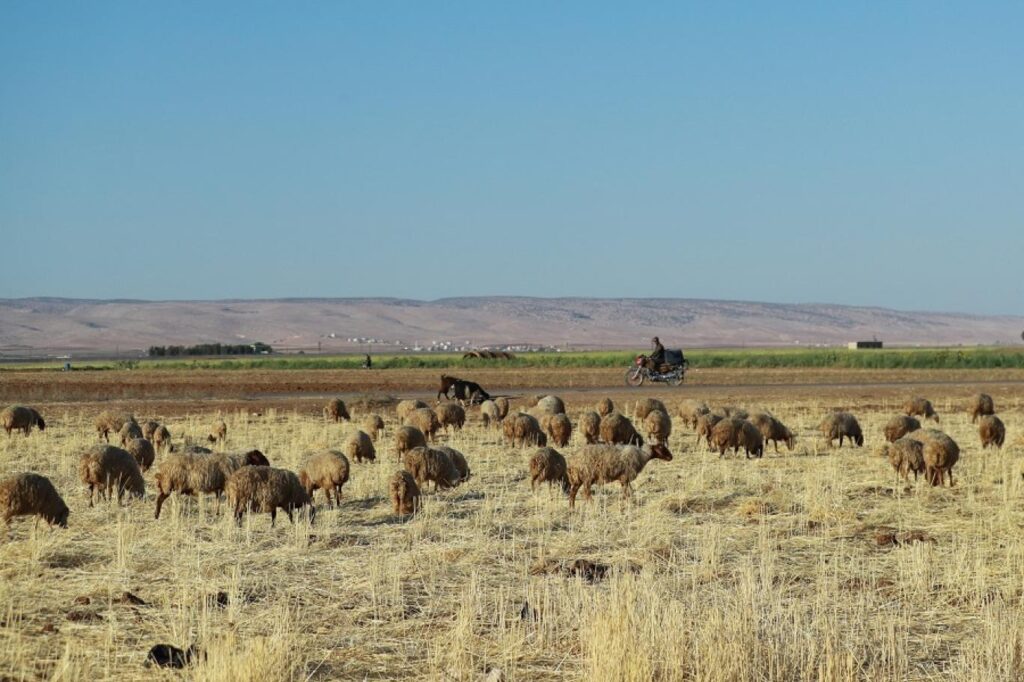Syria, a war-torn country that displaced its people, destroyed their homes and squandered their livelihoods, also did not escape the repercussions of climate change, which burdened farmers, especially after the drought hit hard, harvesting their agricultural crops relentlessly before their pickaxes harvested them or harvested the fruits of their orchards and green orchards.
Climatic factors and the risk of famine
The current season disappointed the farmers and increased their accumulated and successive losses year after year after a successive lean year, increasing their anxiety that did not cease to lurk them due to the dangers of drought and its effects from climate changes, in addition to fires and disasters that affected forests and plantations of citrus and olive trees, which caused more calamities that pushed the country In the end, Moscow sought help to import wheat, as Syria’s need is estimated at about one million tons annually.
As a result of drought and climate change, the United Nations warned of an exacerbating hunger crisis, and the World Food Program report pointed to the threat of starvation to 12 million Syrians, and their food insecurity is due to climatic factors. A recent report by the same organization indicated that Syria is among the nine countries at high risk of climatic events, and it ranks as the third highest risk of drought.
The UN organization also warned of a looming water crisis, and revealed that approximately 40 percent of irrigated agricultural areas no longer have the ability to rely on irrigation. More suffering.
A series of interconnected disasters
The danger facing the Syrians is widening and warns of growing disasters, according to environmental engineer Shehadeh, who declared that the matter is getting worse with the decrease in the level of the Euphrates River flowing from Turkish territory to unprecedented levels, as the amount of water reaches less than half, 200 cubic meters per second, while the agreed quantity 500 cubic meters per second.
“The matter that left a large part of the irrigated areas out of service, including the cultivation of wheat, cotton and vegetables, with the scarcity and depletion of groundwater wells in northeastern Syria.”
climate and the threat to the stability of states
And if a local team believes that climate change today represents the first threat to stability, then an American study led to the crisis that befell Syria, the repercussions of which are living for this moment, caused by climate change, and according to a study published by John Waterbury in 2013, in which it was reported that droughts since 2011 led to Converting agricultural land in eastern Syria, where 800,000 people benefit from it, to barren land, and the death of no less than 85 percent of livestock.
The study added that this environmental disaster led to a large exodus from rural areas in search of job opportunities in major cities, and with it formed slums surrounding those cities such as Hama, Homs and Daraa, which contributed to fueling the conflict.
Perhaps the preliminary assessment by a network of experts concerned with climate and environmental changes in the Mediterranean region in 2019 concluded that the disintegration of the Syrian rural economy is one of the likely factors in the recent Syrian war, as the gap between rural and urban areas increases, accompanied by high rates of unemployment and widespread poverty.
This hypothesis linking climate change to the Syrian war has been the subject of widespread controversy among experts and specialists in a wide range, with opinions divided on that side, and climate experts in the Mediterranean basin believe in a study of them that the recent droughts, which are the longest and worst in the past 900 years, may It played in stirring up the crisis, while today the Syrians see its results on barren, barren land and thirsty for greenery and water.












